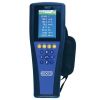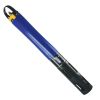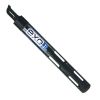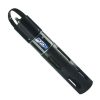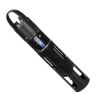YSI EXO3 Multi-Parameter Water Quality Sonde
Features
- Titanium sensors with wet-mateable, universal sensor ports
- Biofouling protection with central wiper brush and copper-alloy accessories
- Integral SDI-12 communications make it ideal for data collection platforms
- Expedited repair and warranty service
- Lifetime technical support
- More
Modern and Efficient Design
The YSI EXO3 represents an advanced sonde platform that offers a wide range of capabilities to those dedicated to monitoring natural aquatic environments such as oceans, estuaries, rivers, lakes, and groundwater. With a highly efficient power management platform, robust construction, and chemistry-free anti-fouling system, the EXO3 allows accurate data collection for up to 90 days between service intervals.
Multi-Port Water Quality Sonde
The YSI EXO3 sonde includes four sensor ports and a central anti-fouling wiper option. Sensor (sold separately) parameters include:
- Temperature
- Conductivity
- Depth
- Dissolved oxygen
- pH
- ORP
- Total algae (phycocyanin or phycoerythrin along with chlorophyll)
- Turbidity
- Fluorescent dissolved organic matter (fDOM)
- Rhodamine WT
- UV nitrate
- ISE ammonium
- ISE nitrate
- ISE chloride
Outputs Four Calculated Parameters.
- Salinity
- Specific conductance
- Total dissolved solids (TDS)
- Total suspended solids (TSS)
Onboard Signal Processing and Memory
All EXO sensors are digital sensors with onboard signal processing and memory. Built-in sensor diagnostic and calibration data allow users to calibrate multiple sensors in one sonde and distribute them to various other sondes in the field. Wet-mateable connectors allow for swaps in wet conditions, while active port monitoring automatically detects each sensor and verifies operation.
EXO3 Specifications
Diameter: 7.62cm (3.00 in)
Length: 58.67cm (23.10 in)
Peripheral Ports: 1 power communication port
Sensor Ports: 5 (4 ports available when central wiper used)
3-Year Warranty: Sonde; handheld
2-Year Warranty: Cables; conductivity/temperature and optical sensors; electronics base for pH, pH/ORP, ammonium, chloride, and nitrate sensors
1-Year Warranty: Optical DO cap and replaceable reagent modules for pH and pH/ORP sensors
3-Month Warranty: Replaceable reagent modules for ammonium, chloride, and nitrate sensors
Weight: 2.00kg (4.41 lbs)
General Sonde Specifications
Battery Life: 60 days**
Computer Interface: YSIP via USB Signal Output Adapter (SOA) and Bluetooth
Output Options: SDI-12 native output; RS-232 & SDI-12 via DCP-SOA; Modbus & RS-485 via Modbus-SOA
Data Memory: 512 MB total memory; >1,000,000 Logged readings
Depth Rating: 0 to 250m (0 to 820 ft)
Sample Rate: Up to 4 Hz
Operating Temperature: -5 to +50°C (23 to 122°F)
Storage Temperature: -20 to +80°C (-4 to 176°F)
**Typically 60 days at 20˚C at 15-minute logging interval; temperature/conductivity, pH/ORP, DO, and turbidity sensors installed with central wiper that rotates once per logging interval on EXO3. Battery life is heavily dependent on sensor configuration.
- (1) EXO3 sonde
- (1) Probe guard
- (1) Calibration cup
- (1) Tool kit
- (3) Port plugs
- (2) D-cell alkaline batteries
- (1) USB drive loaded with manual & KOR Software
- YSI EXO Multi-Parameter Water Quality Sonde Brochure
- YSI EXO Multi-Parameter Water Quality Sonde Manual
- YSI EXO Multi-Parameter Water Quality Sonde Quick Start Guide
- YSI EXO Multi-Parameter Water Quality Sonde SmartQC Handbook
- Guide to Monitoring Turbidity at Dredging Sites
- Guide to Monitoring Water Quality on Inland Lakes
In The News
Great Lakes Research Center: Designing Targeted Monitoring Solutions
According to the National Oceanic and Atmospheric Administration ( NOAA ), the Great Lakes have more miles of coastline than the contiguous Atlantic and Pacific coasts combined and contain 20 percent of the world's freshwater, making it a critical region to protect and conserve. Continuous monitoring and data-informed resource management are key components of managing waters in the region. Hayden Henderson, a research engineer with the Great Lakes Research Center (GLRC), designs and deploys monitoring platforms throughout the Great Lakes. With a background in environmental engineering, Henderson enjoyed the challenge of creating systems and making them work to obtain difficult, remote measurements.
Read MoreMonitoring Meadowbrook Creek: Real-Time Data Collection in an Urban Creek
Meadowbrook Creek in Syracuse, New York, has been monitored by Syracuse University (SU) faculty and students for over a decade. Originally established by Dr. Laura Lautz in 2012, the early years of the program focused on collecting grab water samples for laboratory analysis and evaluating the impact of urban land use, human activities, and natural processes on water resources. Tao Wen , an Assistant Professor in SU’s Department of Earth and Environmental Sciences, took over the program in 2020 and upgraded the existing systems to include 4G modems that allowed for real-time data viewing. [caption id="attachment_39339" align="alignnone" width="940"] An overview of the Fellows Ave monitoring station along Meadowbrook Creek.
Read MoreBuoy-Based Solutions: Strengthening Kentucky’s Emergency Response Efforts
When Kentucky’s Emergency Response Team (ERT) has to act quickly in response to chemical and oil spills in the Commonwealth, they rely on small, easily deployable buoys to collect critical data that help minimize and evaluate damages in environmental emergencies. With a background in geology, Robert Blair primarily worked with groundwater and got involved sporadically with the ERT during groundwater contamination emergencies. Over time, this involvement led to him joining the ERT as an On-Scene Coordinator and then becoming the branch manager for the team and overall Emergency Response Branch .
Read More























































